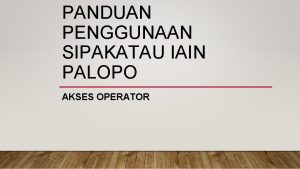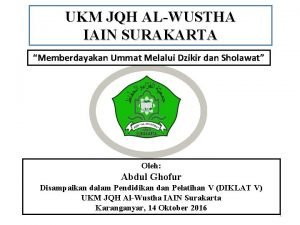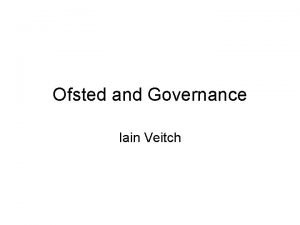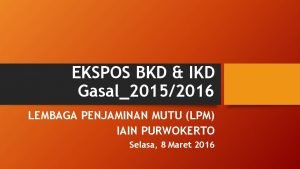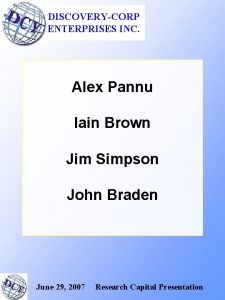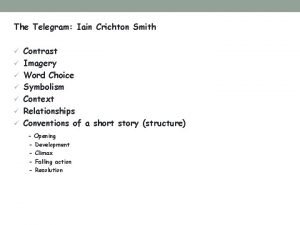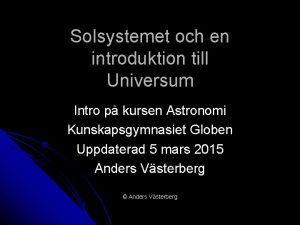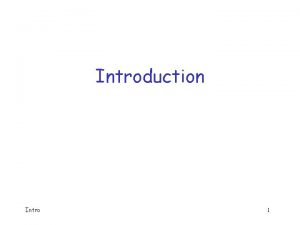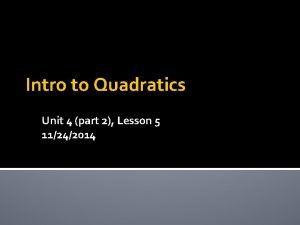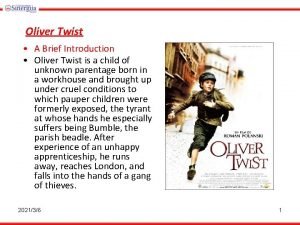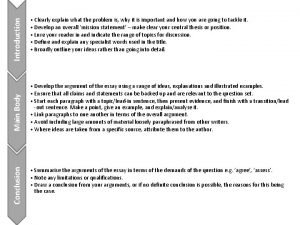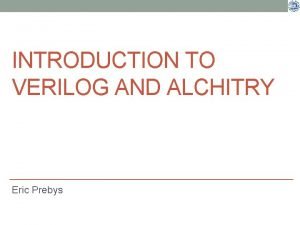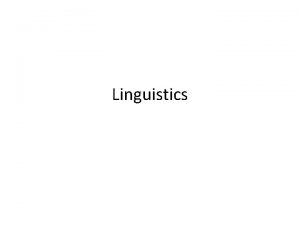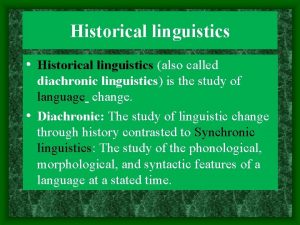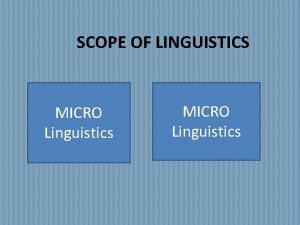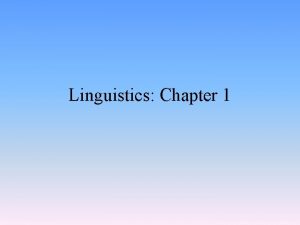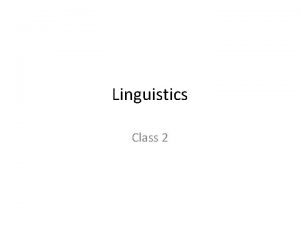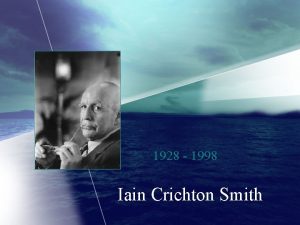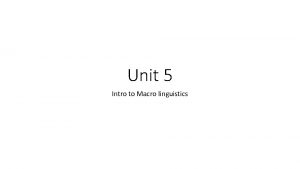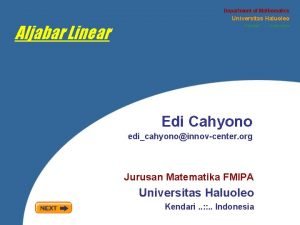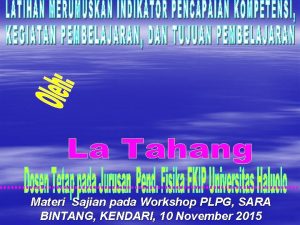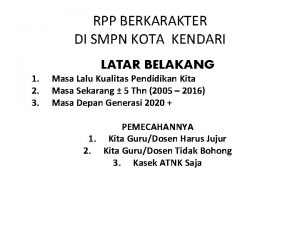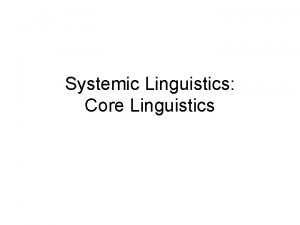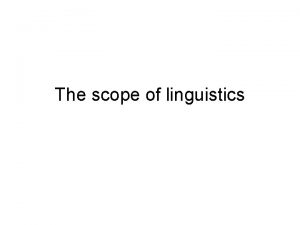INTRO TO LINGUISTICS IAIN KENDARI 2 3 MEETING
















































- Slides: 48

INTRO TO LINGUISTICS IAIN KENDARI, 2 -3 MEETING

QUESTIONS TO ANSWER • Watch the video then answer these questions! 1. What is the nature of language? 2. What is language? 3. Why should one study linguistics?

LINGUISTICS • What is language? • The scope of linguistics • The definition

QUESTIONS 1. What is language? 2. What if there were no language? 3. What function does language play in daily life? 4. Is language human specific? 5. Do animal have language?

LANGUAGE Latin Lang (Lingua) French Italian (langue, langage) (lingua) Lengua English (Spanish) (Language)

Ferdinand de Saussure (Switzerland Course de linguistique generale (1916) (Langage, Langue and parole) Langage (More universal) Langue (Specific) Parol (Speech), accent, utterance Linguist -> polyglot (Greek : Polys (many), glotta (languages) -> Attitude, manner. (Politeness)

SCOPE OF LINGUISTICS

OBJECT OF LINGUISTICS Language • figurative language • Language literally (langange, langue, parole) Orthography -> greek , orthos (correct), graphein (writing) Philology (Eng); philologie (French)

DEFINITION OF LANGUAGE • • • Language as a system Language as arbitrary Language as a vocal Language as a symbol Language as human Language as communication

THE DEFINITION OF LANGUAGE • Language is purely human and non-instinctive method of communicating ideas, emotions and desires by means of voluntarily produced symbol (Sapir, 1921) • Language is a system of arbitrary, vocal symbols which permit all people in a given culture, which permit all people in given culture, or other people who have learned the system of that culture is communicative to communicate or to interact (Finocchiaro, 1965)

THE DEFINITION OF LANGUAGE • Language is a system of communication by sound, operating through the organ of speech, among members of a given community, and using vocal symbols possessing arbitrary conventional meaning (Pei, 1966) • The generally accepted definition: Language is a system of arbitrary vocal symbols used for human communication (Wardhough, 1972)

E x p l a n a t io n s Firstly, language is a system, i. e. , elements of language are combined according to rules. “iblk”, “Been he wounded has” are unacceptable. Secondly, language is arbitrary in the sense that there is no intrinsic connection between the word ‘pen’ and the thing we use to write with.

Explanations he fact that t The different language have different words for the same object is a good illustration of the arbitrary nature of language. This also explain the symbolic nature of language: words are just symbols; they are associated with objects, actions, ideas, etc, by convention. “A rose by any other name would smell as sweet”. (Romeo and Juliet)

Explanations Thirdly, Thirdl language is vocal because the primary medium is sound for all languages, no matter how well developed their writing systems are. All evidence points to the fact that writing systems came into being much later than the spoken forms and that they are only attempts to capture sounds and meaning on paper. “children – spoken language – read and write”

Design Features of Language refer to the quintessential characteristics of human language, which can distinguish any human language system from any non-human language system. They cover: Arbitrariness, Duality, Creativity, Displacement, and Cultural transmission.

Design Features of Language Arbitrariness � This feature was first proposed by Saussure. � The forms of linguistic signs bear no natural (logical, intrinsic) relationship to their meaning. � “Different sounds are used to refer to the same object in different languages. ” Baum tree �

Arbitrariness At lexical level: A rose by any other name would smell as sweet (Shakespeare's Romeo and Juliet, 1594 )

Arbitrariness at the syntactic level language is not arbitrary at the syntactic level. (a) He came in and sat down. (b) He sat down and came in. (c) He sat down after he came in.

How to understand Arbitrariness and convention?

Design Features of Language Duality Language possess the property of having two levels of structures: Sounds (lower or basic level) Meaning (higher level) Sounds are combined with one another to form meaningful units such as words. The secondary units sounds are meaningless and the primary units have distinct and identifiable meaning.

Design Features of Language Creativity Language can be used to send messages we have never said or heard before. Creativity is unique to human language. Language is creative in that it makes possible the construction and interpretation of new signals by its users.

Creativity cool Words can be used in new ways to mean new things, and can be instantly understood by people who have never come across that usage before.

Creativity Languagee is resourceful because of its res duality and its recursiveness. The recursive nature of language provides a potential to create an infinite number of /endless sentences. “Limited rules can produce unlimited sentences. ” (Chomsky, 1958).

Creativity For instance: This is the cat that killed the rat that ate the malt that lay in the house that Jack built. He bought a book which was written by a teacher who taught in a school which was known for its graduates who. . .

D e s i g n Features of Language Creativity Users can understand produce words or sentences they have never heard before. Every day we sent messages that have never been sent before and understand novel messages. Much of what we say and hear for the first time; yet there seems no problem of understanding.

Displacement Design Features of Language Human languages enable their users to symbolize objects, events and concepts which are not present (in time and space) at the moment of communic ation. Thus, we can refer to Confucius, or the North Pole, even though the first has been dead for over 2550 years and the second is situated far away from us.

Displacement imal communication co Animal is normally under “immediate stimulus control”. For instance, a warning cry of a bird instantly announces danger. My master will be home in a few days. × The honeybee's dance exhibits displacement a little bit: he can refer to a source of food, which is remote in time and space when he reports on it.

Displacement Human language is stimulus-free. What we are talking about need not be triggered by any external stimulus in the world or any internal state. Our language enables us to communicate about things that do not exist or do not yet exist.

Displacement benefits human beings by giving us the power to handle generalizations and abstractions.

Design Features of Language Cultural transmission Animal call systems are genetically transmitted. Language is culturally transmitted. It is passed on from one generation to the next by teaching and learning, rather than by instinct.

Topics for discussion No matter how eloquently a dog may bark, he cannot tell you that his parents were poor but honest. - Bertrand Russell A rose by other name would smell as sweet. – Shakespeare He bought a book which was written by a teacher who taught in a school which was known for its graduates who … /tr/, /a/, /n/, /s/, /l/, /ei/, /t/- translate – translate a novel- translate a novel by Lu Xun

Do we have language ?

language functions Metafunctions of Language proposed by Halliday Ideational function (a model ode of o experiences experience aas well as logical relations. ; Interpersonal Function (to o eestablish tab ish and maintain social relations ) and hip ; Textual function (to creates relevance to context).

language functions Informative Interpersonal Performative Emotive Phatic communion Recreational Metalingual

Functions of Language Informative Language is used to convey messages, that is to inform somebody of some information. Declarative sentences are employed to realize the function. One of the features of this function is the proposition has the true or false value, e. g. Water boils at 90ºC. Water boils at 100ºC.

Functions of Language Interpersonal By far the most important sociological use of language, and by which people establish and maintain their status in a society, “polite expressions, humble words”, expression of identity. For example, the ways in which people address others (Dear Sir, Dear Professor, Johnny), and refer to themselves (yours, your obedient servant ) indicate the various grades of interpersonal relations.

Functions of Language Interpersonal In the framework of functional grammar, it is concerned with interaction between the addresser and addressee in the discourse situation and the addresser's attitude toward what he speaks or writes about.

Functions of Language Performative function This concept originates from the philosophical study of language represented by Austin and Searle, whose theory now forms the back-bone of pragmatics. For example, – I now declare the meeting open. – I bet you two pounds it will rain tomorrow.

Functions of Language Performative function It is to change the social status of persons, as in marriage ceremonies, the sentencing of criminals, the blessing of children, the naming of a ship at a launching ceremony, and the cursing of enemies. (formal and ritualized)

The performative function can extend to the control of reality as on so some magical or religious occasions. – For example, in Chinese when someone breaks a bowl or a plate the host or the people present are likely to as a means of say � � 平 安 invisible controlling forces whichthe believers feel might affect their lives adversely.

Functions of Language Emotive function to change the emotional status of an audience for or against someone or something: swear words, obscenities, involuntary verbal reactions to beautiful art or scenery; conventional words/phrases, ( e. g. , My God, Damn it, What a sight, Wow, Ugh, Ow… )

Functions of L anguage Phatic communion It refers to the social interaction of language. Small, seemingly meaningless topic to maintain a comfortable relationship between people without involving any factual content, “health, weather” Expressions that help define and maintain interpersonal relations, such as slangs, jokes, jargons, ritualistic exchanges, switches to social and regional dialects.

Phatic communion We all use such small, seemingly meaningless expressions to maintain a comfortable relationship between people without involving any factual content. Good morning, God bless you, Nice day, hello 吃� 了� ?到哪里去? Greetings, farewells, and comments on the weather in English and on clothing in Chinese

Functions of Language Recreational function To use language for the sheer joy of using it, such as a baby’s babbling, a chanter’s chanting, verbal dueling, poetry writing. To take one example, the well-known movie 《 刘 三 姐 》 features a scene of “ � 歌 ” (song dueling) mostly for the sheer joy of playing on language.

Functions of Language Metalingual function Language can be used to talk about itself. metalanguage ( 元 � 言 ; � 理 � 言 ) : certainkinds of linguistic signs or terms for the analysis and description of particular studies, e. g. approving, formal, non technical, old-fashioned; [u] , [c], etc.

Functions of Language Informative Hello, do you know …? I heard tthat … With language people can express With themselves and communicate with others. Inter-personal Dear sir, Dear professor, John, yours, your obedient servant By language people establish and maintain their social status in a society. Performative Marriage ceremonies, the sentence of a criminal, sui ping an (to break a bowl on Spring Festival) People use language to to change social status People or control the reality on some special occasions Emotive Oh, my my God! What aa sight. Oh, And hurrah! Language can be used to get rid of the nervous energy when we are under stress Phatic Good morning! Thank you. God bless you. language is is used to to maintain aa comfortable language relationship between people without involving any factual content Recreational Tip tongue, poetry writing gives people Tip the pleasure of using language. People use language for the sheer of joy. Meta-lingual book---- number of printed or written sheets of paper bound together in a cover. People use language to to talk about language People itself.

Linguistics can be defined as the scientific or systematic study of language. It is a science in the sense that it scientifically studies the rules, systems and principles of human languages.

Linguistics has two main purposes One is that it studies the nature of language and tries to establish a theory of language and describes languages in the light of theory established. The other is that it examines all the forms of language in general and seeks a scientific understanding of the ways in which it is organized to fulfill the needs it serves and the functions it performs in human life.
 Language
Language History of applied linguistics
History of applied linguistics Today meeting or today's meeting
Today meeting or today's meeting What is meeting and types of meeting
What is meeting and types of meeting Types of meeting
Types of meeting Today meeting or today's meeting
Today meeting or today's meeting Sipakatau iain palopo
Sipakatau iain palopo Chef pic
Chef pic Ukm iain surakarta
Ukm iain surakarta Iain moffat
Iain moffat The telegram short story
The telegram short story Iain greenway
Iain greenway Iain veitch
Iain veitch Iain mansfield
Iain mansfield Iain crichton smith the telegram
Iain crichton smith the telegram The telegram iain crichton smith
The telegram iain crichton smith Bkd iain purwokerto
Bkd iain purwokerto Iain shepherd
Iain shepherd The red door short story analysis
The red door short story analysis What is an adjunct display
What is an adjunct display Iain giles cibc
Iain giles cibc Crichton
Crichton Mooting skeleton argument example
Mooting skeleton argument example Intro qr codes
Intro qr codes Street hockey positions
Street hockey positions Proportion
Proportion Thermochemistry conversions
Thermochemistry conversions Rekenverhalen intro
Rekenverhalen intro Neptunus fakta
Neptunus fakta What is a bridge in an introduction paragraph
What is a bridge in an introduction paragraph Apush thesis statement example
Apush thesis statement example Example of an introduction paragraph
Example of an introduction paragraph Whats an intro paragraph
Whats an intro paragraph Intro definition
Intro definition Unit 4 part 2
Unit 4 part 2 S2atp
S2atp Intro affix
Intro affix Dalawang uri ng wakas
Dalawang uri ng wakas Intro to semiconductors
Intro to semiconductors Schaffer writing method
Schaffer writing method Php intro
Php intro Oliver twist summary
Oliver twist summary Body conclusion introduction
Body conclusion introduction Intro to vlsi
Intro to vlsi Sujet posé exemple
Sujet posé exemple Intro to piecewise functions
Intro to piecewise functions Hook line for romeo and juliet
Hook line for romeo and juliet Sweetener
Sweetener Intro to verilog
Intro to verilog






